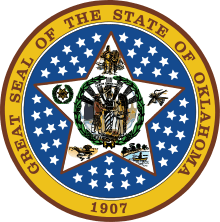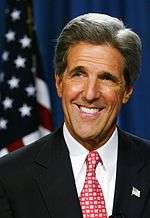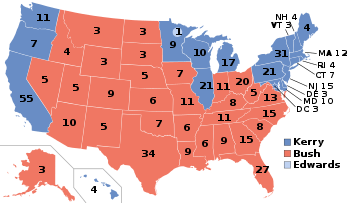United States presidential election in Oklahoma, 2004
| | ||||||||||||||||||||||||||||||||
| ||||||||||||||||||||||||||||||||
| ||||||||||||||||||||||||||||||||
|
| ||||||||||||||||||||||||||||||||
| County Results
Bush—50-60%
Bush—60-70%
Bush—70-80%
Bush—80-90% | ||||||||||||||||||||||||||||||||
| ||||||||||||||||||||||||||||||||
The 2004 United States presidential election in Oklahoma took place on November 2, 2004 throughout all 50 states and D.C., which was part of the 2004 United States presidential election. Voters chose 7 representatives, or electors to the Electoral College, who voted for President and Vice President.
Oklahoma was won by incumbent President George W. Bush by a 31.1% margin of victory. Prior to the election, all 12 news organizations considered this a state Bush would win, or otherwise considered as a safe red state. Bush won this state, every single county, and congressional district. Giving Bush nearly 66% of the vote, it was the most Republican state in the south and one of Bush's best performances in the country. In addition, he performed nine points better here than in 2000, indicating the state is trending Republican.
Primaries
Campaign
Predictions
| Elections in Oklahoma |
|---|
 |
There were 12 news organizations who made state by state predictions of the election. Here are their last predictions before election day.[1]
- D.C. Political Report: Solid Republican
- Associated Press: Solid Bush
- CNN: Bush
- Cook Political Report: Solid Republican
- Newsweek: Solid Bush
- New York Times: Solid Bush
- Rasmussen Reports: Bush
- Research 2000: Solid Bush
- Washington Post: Bush
- Washington Times: Solid Bush
- Zogby International: Bush
- Washington Dispatch: Bush
Polling
Bush won every single pre-election poll, each with a double digit margin and with at least 53% of the vote, except for the first poll. Many polls had Bush winning with a 30% margin or even higher. The final 3 poll average had Bush leading 63% to 32%.[2]
Fundraising
Bush raised $1,194,549.[3] Kerry raised $357,038.[4]
Advertising and visits
Neither campaign advertised or visited this state during the fall campaign.[5][6]
Analysis
Bush won here in 2000 with just 60% of the vote, and losing several counties in the eastern part of the state. However, the major difference between 2000 and 2004 is that in 2000 the Reform Party and Libertarian Party candidates were on the ballot. Oklahoma now has the toughest laws for a third party candidate to get ballot access, as no independent has gotten ballot access here since 2000. Bush won every single county in 2004, including winning statewide with over 65% of the vote, which is one of Bush's best performances in the nation. Bush's key to victory was gaining the heavily populated counties of Tulsa County and Oklahoma County with over 64% of the vote in each.
Results
| United States presidential election in Oklahoma, 2008[7] | ||||||
|---|---|---|---|---|---|---|
| Party | Candidate | Running mate | Votes | Percentage | Electoral votes | |
| Republican | George W. Bush | Dick Cheney | 959,792 | 65.57% | 7 | |
| Democratic | John Kerry | John Edwards | 503,966 | 34.43% | 0 | |
| Voter turnout (Voting age population) | 55.6% | |||||
Results breakdown
By county
| County | Bush# | Bush% | Kerry# | Kerry% |
|---|---|---|---|---|
| Adair | 4,970 | 66% | 2,560 | 34% |
| Alfalfa | 2,201 | 82% | 470 | 18% |
| Atoka | 3,140 | 62% | 1,946 | 38% |
| Beaver | 2,271 | 88% | 297 | 12% |
| Beckham | 5,454 | 74% | 1,931 | 26% |
| Blaine | 3,199 | 72% | 1,222 | 28% |
| Bryan | 8,614 | 60% | 5,742 | 40% |
| Caddo | 6,491 | 62% | 3,916 | 38% |
| Canadian | 33,297 | 77% | 9,712 | 23% |
| Carter | 12,173 | 65% | 6,464 | 35% |
| Cherokee | 9,563 | 53% | 8,622 | 47% |
| Choctaw | 3,168 | 55% | 2,639 | 45% |
| Cimarron | 1,242 | 87% | 184 | 13% |
| Cleveland | 65,666 | 66% | 33,984 | 34% |
| Coal | 1,396 | 54% | 1,203 | 46% |
| Comanche | 21,163 | 64% | 12,020 | 36% |
| Cotton | 1,742 | 66% | 898 | 34% |
| Craig | 3,894 | 61% | 2,504 | 39% |
| Creek | 18,845 | 66% | 9,927 | 35% |
| Custer | 7,839 | 74% | 2,801 | 26% |
| Delaware | 10,016 | 64% | 5,591 | 36% |
| Dewey | 1,843 | 82% | 408 | 18% |
| Ellis | 1,685 | 81% | 395 | 19% |
| Garfield | 17,685 | 76% | 5,586 | 24% |
| Garvin | 7,610 | 67% | 3,706 | 33% |
| Grady | 14,129 | 70% | 5,969 | 30% |
| Grant | 1,950 | 77% | 571 | 23% |
| Greer | 1,529 | 68% | 719 | 32% |
| Harmon | 838 | 70% | 354 | 30% |
| Harper | 1,397 | 84% | 268 | 16% |
| Haskell | 2,946 | 55% | 2,378 | 45% |
| Hughes | 3,066 | 57% | 2,286 | 43% |
| Jackson | 7,024 | 76% | 2,232 | 24% |
| Jefferson | 1,546 | 59% | 1,057 | 41% |
| Johnston | 2,634 | 61% | 1,711 | 39% |
| Kay | 14,177 | 70% | 5,956 | 30% |
| Kingfisher | 5,629 | 85% | 1,022 | 15% |
| Kiowa | 2,608 | 65% | 1,413 | 35% |
| Latimer | 2,535 | 57% | 1,945 | 43% |
| LeFlore | 10,681 | 61% | 6,740 | 39% |
| Lincoln | 10,149 | 72% | 4,041 | 28% |
| Logan | 11,467 | 70% | 4,869 | 30% |
| Love | 2,295 | 60% | 1,538 | 40% |
| Major | 3,120 | 85% | 537 | 15% |
| Marshall | 3,363 | 62% | 2,088 | 38% |
| Mayes | 9,946 | 59% | 6,933 | 41% |
| McClain | 10,038 | 73% | 3,742 | 27% |
| McCurtain | 7,472 | 67% | 3,684 | 33% |
| McIntosh | 4,692 | 51% | 4,488 | 49% |
| Murray | 3,665 | 61% | 2,310 | 39% |
| Muskogee | 15,121 | 55% | 12,585 | 45% |
| Noble | 3,993 | 75% | 1,335 | 25% |
| Nowata | 2,805 | 63% | 1,659 | 37% |
| Okfuskee | 2,542 | 59% | 1,743 | 41% |
| Oklahoma | 174,707 | 64% | 97,283 | 36% |
| Okmulgee | 8,363 | 53% | 7,367 | 47% |
| Osage | 11,467 | 59% | 8,068 | 41% |
| Ottawa | 7,439 | 59% | 5,084 | 41% |
| Pawnee | 4,412 | 63% | 2,563 | 37% |
| Payne | 19,560 | 66% | 10,101 | 34% |
| Pittsburg | 11,134 | 60% | 7,452 | 40% |
| Pontotoc | 9,642 | 65% | 5,165 | 35% |
| Pottawatomie | 17,212 | 67% | 8,636 | 33% |
| Pushmataha | 2,862 | 60% | 1,934 | 40% |
| Roger | 1,388 | 78% | 382 | 22% |
| Rogers | 24,981 | 68% | 11,917 | 32% |
| Seminole | 5,623 | 61% | 3,648 | 39% |
| Sequoyah | 8,865 | 60% | 5,910 | 40% |
| Stephens | 13,645 | 71% | 5,514 | 29% |
| Texas | 5,449 | 84% | 1,016 | 16% |
| Tillman | 2,273 | 66% | 1,175 | 34% |
| Tulsa | 163,434 | 64% | 90,204 | 36% |
| Wagoner | 19,081 | 68% | 9,157 | 32% |
| Washington | 16,551 | 71% | 6,862 | 29% |
| Washita | 3,705 | 73% | 1,340 | 27% |
| Woods] | 3,165 | 77% | 930 | 23% |
| Woodward | 6,188 | 81% | 1,457 | 19% |
By congressional district
Bush won all five congressional districts.[8]
| District | Bush | Kerry | Representative |
|---|---|---|---|
| 1st | 65% | 35% | John Sullivan |
| 2nd | 59% | 41% | Brad Carson |
| Dan Boren | |||
| 3rd | 72% | 28% | Frank Lucas |
| 4th | 67% | 33% | Tom Cole |
| 5th | 64% | 36% | Ernest Istook |
Electors
Technically the voters of Oklahoma cast their ballots for electors: representatives to the Electoral College. Oklahoma is allocated 7 electors because it has 5 congressional districts and 2 senators. All candidates who appear on the ballot or qualify to receive write-in votes must submit a list of 7 electors, who pledge to vote for their candidate and his or her running mate. Whoever wins the majority of votes in the state is awarded all 7 electoral votes. Their chosen electors then vote for President and Vice President. Although electors are pledged to their candidate and running mate, they are not obligated to vote for them. An elector who votes for someone other than his or her candidate is known as a faithless elector.
The electors of each state and the District of Columbia met on December 13, 2004 to cast their votes for President and Vice President. The Electoral College itself never meets as one body. Instead the electors from each state and the District of Columbia met in their respective capitols.
The following were the members of the Electoral College from the state. All 7 were pledged for Bush/Cheney:
- George Wiland
- Paul Hollrah
- Colby Schwartz
- Diana Gunther
- Ken Bartlett
- Donald Burdick
- Bob Hudspeth
References
- ↑ http://www.dcpoliticalreport.com/members/2004/Pred2.htm#NW[]
- ↑ http://uselectionatlas.org/USPRESIDENT/GENERAL/CAMPAIGN/2004/polls.php?fips=40
- ↑ http://www.campaignmoney.com/political/campaigns/george_w_bush.asp?cycle=04
- ↑ http://www.campaignmoney.com/political/campaigns/john_f_kerry.asp?cycle=04
- ↑ http://www.cnn.com/ELECTION/2004/special/president/tracking/10.11.html
- ↑ http://www.cnn.com/ELECTION/2004/special/president/campaign.ads/
- ↑ http://uselectionatlas.org/RESULTS/
- ↑ http://www.swingstateproject.com/diary/4161/



